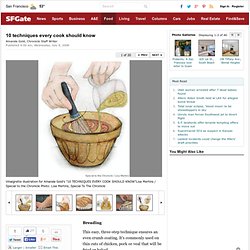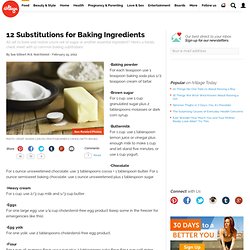

Omotesenke: What is Chanoyu? The Japanese Tea Ceremony) Quick Guide to Every Herb and Spice in the Cupboard. Top 10 Skills to Master Your Grill. @jonny6pak: AFAIC, marinades are NEVER the way to go. I've never had a piece of meat that was somehow made better by soaking it in something. A brine will help tenderize and will flavorize to the extent that you like salt (and yes is much better than any marinade I've had), but honestly, I think a good homemade rub is all you need 99.9% of the time. I rub chicken, pork, and beef with consistently good results. I also coat the outside of beef and pork with olive oil to help with searing. The only meat that gets anything wet at all is ground beef, which gets egg white and Worcestershire (along with oatmeal, cheese (grated or sometimes stuffed with blue cheese), (usually) onion flakes, salt and spices—and a coating of olive oil).
10 techniques every cook should know. Breading This easy, three-step technique ensures an even crumb coating.

It's commonly used on thin cuts of chicken, pork or veal that will be fried or baked. To begin, set up your breading station. Fill the first of three shallow dishes with flour. In the second dish, make an egg wash by whisking eggs with a little bit of water, milk or other liquid or seasoning. Start by dredging a piece of meat in the flour. The second step is to dip the meat into the egg wash, again letting the extra drip off. Try to work with one hand as you complete the process, so as not to bread your fingers on both hands - that can lead to a sticky mess. Proceed with the recipe as directed. Browning/Searing Myths abound about the benefits of searing, most notably that it seals in the juices. The most important factor in this technique is to start with a very hot pan.
Place your ingredient directly into the pan. Dicing an onion If done properly, dicing an onion is very simple. McCormick® Live deliciously™ 12 Substitutions for Baking Ingredients. All set to bake and realize you're out of sugar or another essential ingredient?

Here's a handy cheat sheet with 12 common baking subtitutions By Sue Gilbert M.S. Nutritionist - February 15, 2012 •Baking powder For each teaspoon use 1 teaspoon baking soda plus 1/2 teaspoon cream of tartar. •Brown sugar For 1 cup: use 1 cup granulated sugar plus 2 tablespoons molasses or dark corn syrup. •Buttermilk For 1 cup: use 1 tablespoon lemon juice or vinegar plus enough milk to make 1 cup and let stand five minutes, or use 1 cup yogurt. •ChocolateFor 1 ounce unsweetened chocolate: use 3 tablespoons cocoa + 1 tablespoon butter. •Heavy cream For 1 cup: use 2/3 cup milk and 1/3 cup butter. •EggsFor one large egg: use 1/4 cup cholesterol-free egg product (keep some in the freezer for emergencies like this). •Egg yolkFor one yolk: use 2 tablespoons cholesterol-free egg product.
Kitchen 101: Fruits, Vegetables & Herbs. Kitchen 101: Fruits, Vegetables & Herbs I’d be remiss if I simply focused on imparting technical knowledge in the Kitchen 101 series here at Chasing Delicious.

I’d be downright neglectful if I didn’t talk about ingredients, particularly the biggest misconception about produce today: that it is naturally available year-round. Though you may be able to find just about every type of fruit, vegetable, and herb in the grocery store every day of the year, a majority of this produce is not in season.
If you are buying strawberries in December, you are likely purchasing a fruit that was picked six months ago and stored in a climate controlled facility ever since. Or you are buying a berry that has spent the last few weeks in a shipping container as it treks halfway across the globe from somewhere in the opposite hemisphere. Time spent in transit or storage is not the only inflated aspect of buying produce out of season. Second, become good friends with some local farmers too. Measurements.